The Drying Peace–Athabasca Delta, Canada: Review and Synthesis of Cryo-Hydrologic Controls and Projections to Future Climatic Conditions
Abstract
1. Introduction
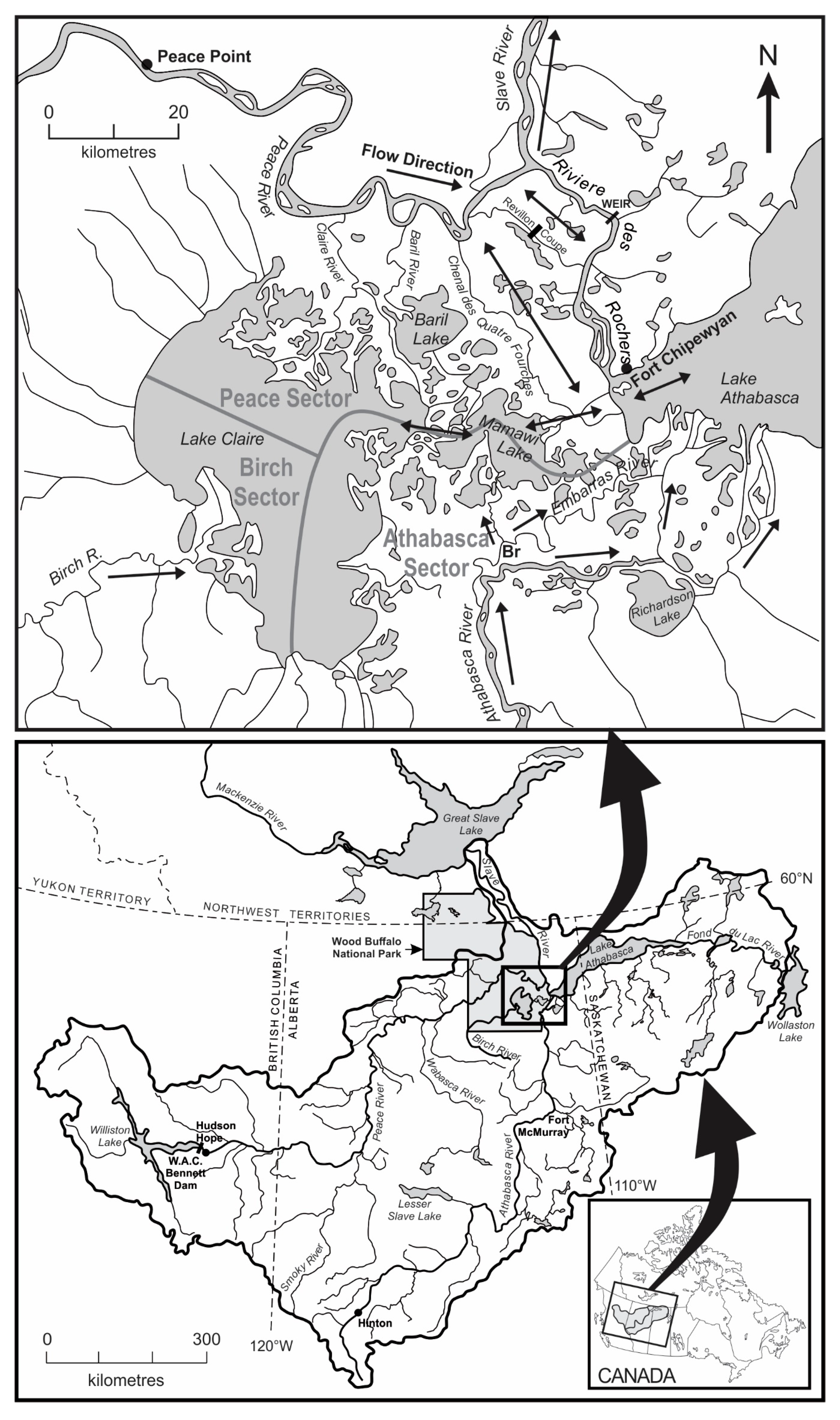
2. Background Information
3. Athabasca Sector and Significance of Morphological Changes
4. Peace Sector and Significance of Regulation
5. Strategies for Restoring Floodwater to Peace Sector Basins
5.1. Spring Flow Releases
5.2. Freezeup Stage Reductions
5.3. Overall Assessment
6. Summary
Funding
Institutional Review Board Statement
Informed Consent Statement
Data Availability Statement
Acknowledgments
Conflicts of Interest
Appendix A. The Debate on the Effects of Regulation on the Frequency of IJFs in the Lower Peace River
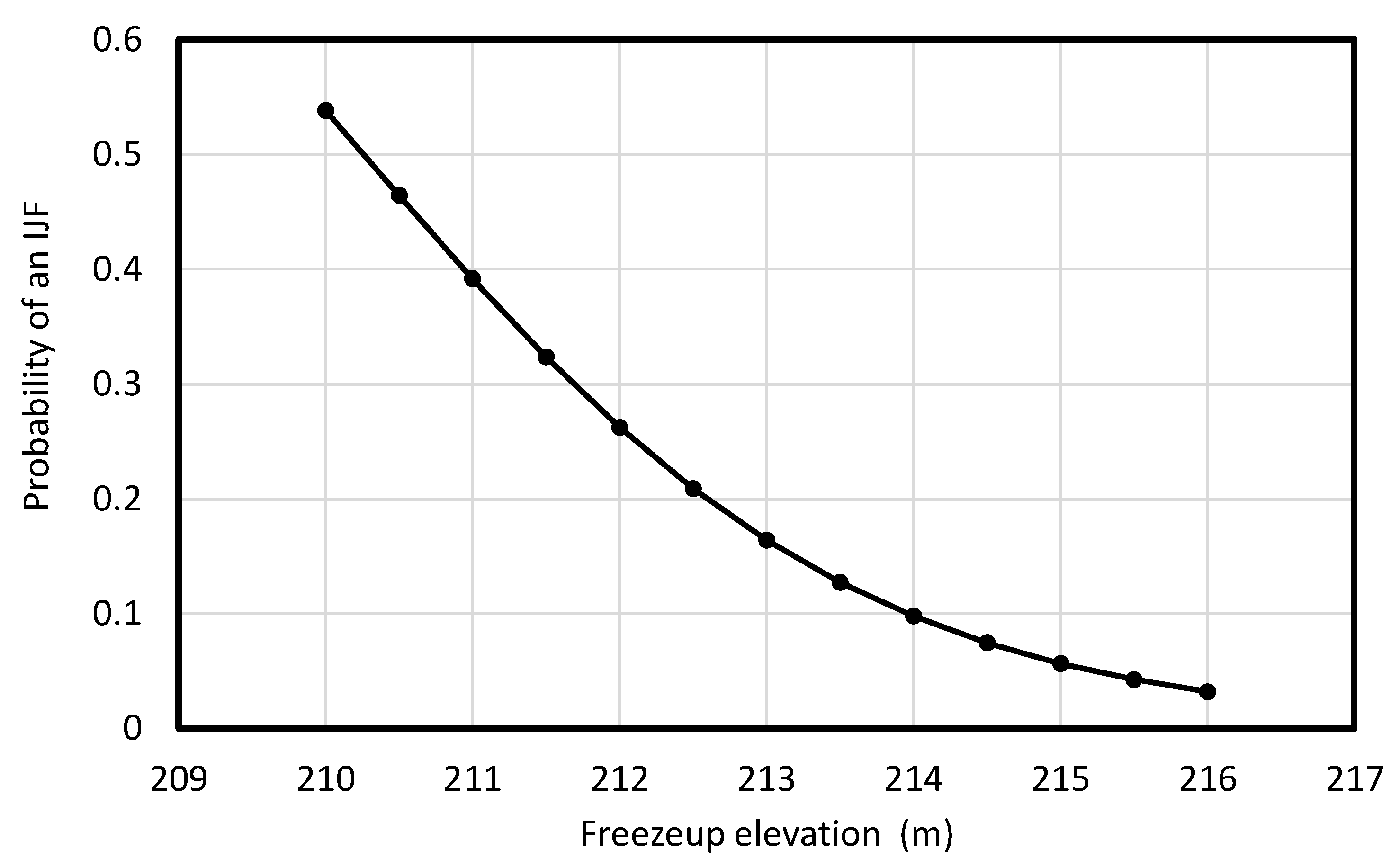
References
- WBNP. Development of a Multi-Jurisdiction Action Plan to Protect the World Heritage Values of Wood Buffalo National Park; Parks Canada: Fort Smith, Canada, 2019; ISBN R64-546/2019E-PDF. Available online: https://publications.gc.ca/site/eng/9.866972/publication.html (accessed on 14 January 2023).
- Parks Canada. The Peace-Athabasca Delta. 2022. Available online: https://www.ibacanada.ca/site.jsp?siteID=AB002 (accessed on 12 January 2023).
- Smith, D.G.; Hubbard, S.M.; Lavigne, J.; Leckie, D.A.; Fustic, M. Stratigraphy of counter-point-bar and eddy-accretion deposits in low-energy meander belts of the Peace-Athabasca Delta, Northeast Alberta, Canada. In River to Rock Record: The Preservation of Fluvial Sediments and their Subsequent Interpretation; SEPM Special Publication No. 97; Society for Sedimentary Geology: Broken Arrow, OK, USA, 2011; pp. 143–152. [Google Scholar]
- Peace-Athabasca Delta Project Group. The Peace-Athabasca Delta, A Canadian Resource; Summary Report; The Peace-Athabasca Delta Project Group: Saskatchewan, AB, Canada, 1972; 144p. [Google Scholar]
- Peace-Athabasca Delta Project Group. Peace-Athabasca Delta Project; Technical Report; The Peace-Athabasca Delta Project Group: Saskatchewan, AB, Canada, 1973; 176p. [Google Scholar]
- Prowse, T.D.; Aitken, B.; Demuth, M.N.; Peterson, M. Strategies for restoring spring flooding to a drying northern delta. Regul. Rivers Res. Manag. 1996, 12, 237–250. [Google Scholar] [CrossRef]
- Prowse, T.D.; Peters, D.; Beltaos, S.; Pietroniro, A.; Romolo, L.; Töyrä, J.; Leconte, R. Restoring Ice-jam Floodwater to a Drying Delta Ecosystem. Water Int. 2002, 27, 58–69. [Google Scholar] [CrossRef]
- Peters, D.L. Controls on the Persistence of Water in Perched Basins of the Peace-Athabasca Delta, Northern Canada. Ph.D. Thesis, Trent University, Peterborough, ON, Canada, 2003. [Google Scholar]
- Peters, D.L.; Prowse, T.D.; Pietroniro, A.; Leconte, R. Flood hydrology of the Peace-Athabasca Delta, northern Canada. Hydrol. Process. 2006, 20, 4073–4096. [Google Scholar] [CrossRef]
- Ward, E.M.; Gorelick, S.M. Drying drives decline in muskrat population in the Peace-Athabasca Delta, Canada. Environ. Res. Lett. 2018, 13, 124026. [Google Scholar] [CrossRef]
- Ward, E.M.; Wysong, K.; Gorelick, S.M. Drying landscape and interannual herbivory-driven habitat degradation control semiaquatic mammal population dynamics. Ecohydrology 2020, 13, e2169. [Google Scholar] [CrossRef]
- Ward, E.M.; Solari, K.A.; Varudkar, A.; Gorelick, S.M.; Hadly, E.A. Muskrats as a bellwether of a drying delta. Nat. Commun Biol. 2021, 4, 750. [Google Scholar] [CrossRef] [PubMed]
- Jasek, M.; Pryse-Phillips, A. Influence of the proposed site C hydroelectric project on the ice regime of the Peace River. Can. J. Civ. Eng. 2015, 42, 645–655. [Google Scholar] [CrossRef]
- UNESCO. Reactive Monitoring Mission (RMM) to Wood Buffalo National Park, Canada. Mission Report March 2017. UNESCO World Heritage Centre—WHC International Union for Conservation of Nature (IUCN). 2017. Available online: http://whc.unesco.org/en/documents/156893 (accessed on 14 January 2023).
- Independent Environmental Consultants (IEC). Strategic Environmental Assessment of Potential Cumulative Impacts of All Developments on the World Heritage Values of Wood Buffalo National Park; Final SEA Report; Independent Environmental Consultants (IEC): Markham, ON, Canada, 2018; Volume 1, 247p. [Google Scholar]
- Peterson, M.; Courtorielle, W. Flood history study, Peace/Athabasca Delta, Wood Buffalo National Park; Data Report 92—14/WB; Parks Canada: Fort Chipewyan, AB, Canada, 1992; p. 62. [Google Scholar]
- Thomson, S. Peace-Athabasca Delta Flood History. In Historical Services, Prairie & Northern Region Documentary Information; Appended to Report by Peterson and Courtorielle: Fort Chipewyan, AB, Canada, 1992. [Google Scholar]
- Peterson, M. Peace–Athabasca Flood History Study. In Peace–Athabasca Delta Technical Studies, Task F.1—Flood History; Peace–Athabasca Delta Technical Studies, Communications: Fort Chipewyan, AB, Canada, 1995; p. 32. [Google Scholar]
- Prowse, T.D.; Conly, F.M. Effects of climatic variability and flow regulation on ice-jam flooding of a northern delta. Hydrol. Process. 1998, 12, 1589–1610. [Google Scholar] [CrossRef]
- Beltaos, S. Numerical modelling of ice-jam flooding on the Peace-Athabasca Delta. Hydrol. Process. 2003, 17, 3685–3702. [Google Scholar] [CrossRef]
- Marsh, P.; Lesack, L.; Roberts, A. The environmental effects of ice jam flooding on lakes in the Mackenzie Delta. In Proceedings of the Workshop on Environmental Aspects of River Ice; Prowse, T.D., Ed.; NHRI Symposium Series No. 12; National Hydrology Research Institute: Saskatoon, SK, Canada, 1993; pp. 359–381. [Google Scholar]
- Zhang, F.; Elshamy, M.; Lindenschmidt, K.-E. Climate change impacts on ice jam behavior in an inland delta: A new ice jam projection framework. Clim. Chang. 2022, 171, 1–18. [Google Scholar] [CrossRef]
- Abu, R. Knowledge, use, and change in the Saskatchewan River Delta: Assessing the changing livelihoods of Cumberland House Métis and Cree Nation. Ph.D. Thesis, University of Saskatchewan, Saskatoon, SK, Canada, 2017; 166p. [Google Scholar]
- PFSRB (Partners for the Saskatchewan River Basin). From the Mountains to the Sea: The State of the Saskatchewan River Basin. Saskatoon. 2009. Available online: http://www.saskriverbasin.ca/pages/state_of_the_basin_report.html (accessed on 14 January 2023).
- Prowse, T.D.; Lalonde, V. Open-Water and Ice-Jam Flooding of a Northern Delta. Hydrol. Res. 1996, 27, 85–100. [Google Scholar] [CrossRef]
- Timoney, K.P. The Peace-Athabasca Delta: Portrait of a Dynamic Ecosystem; The University of Alberta Press: Edmonton, AB, Canada, 2013; Available online: www.uap.ualberta.ca (accessed on 14 January 2023).
- Peters, D.L.; Buttle, J.M. The effects of flow regulation and climatic variability on obstructed drainage and reverse flow contribution in a Northern river-lake-Delta complex, Mackenzie basin headwaters. River Res. Appl. 2010, 26, 1065–1089. [Google Scholar] [CrossRef]
- Pariset, E.; Hausser, R.; Gagnon, A. Formation of ice covers and ice jams in rivers. J. Hydraul. Div. 1966, 92, 1–24. [Google Scholar] [CrossRef]
- Beltaos, S. (Ed.) River Ice Jams; Water Resources Publications: Highlands Ranch, CO, USA, 1995. [Google Scholar]
- Beltaos, S. (Ed.) River Ice Breakup; Water Resources Publications: Highlands Ranch, CO, USA, 2008. [Google Scholar]
- Ashton, G.D. (Ed.) River and Lake Ice Engineering; Water Resources Publications: Littleton, CO, USA, 1986. [Google Scholar]
- Ashton, G.D. River and lake ice thickening, thinning, and snow ice formation. Cold Reg. Sci. Technol. 2011, 68, 3–19. [Google Scholar] [CrossRef]
- Beltaos, S.; Bonsal, B. Climate change impacts on Peace River ice thickness and implications to ice-jam flooding of Peace-Athabasca Delta, Canada. Cold Reg. Sci. Technol. 2021, 186, 103279. [Google Scholar] [CrossRef]
- GC (Government of Canada). Adjusted and Homogenized Canadian Climate Data. 2022. Available online: https://www.canada.ca/en/environment-climate-change/services/climate-change/science-research-data/climate-trends-variability/adjusted-homogenized-canadian-data.html (accessed on 6 January 2023).
- Beltaos, S.; Carter, T. Minor 2020 ice jamming in lower Peace River despite extreme breakup flows: Assessment of hydroclimatic controls. In Proceedings of the CGU HS Committee on River Ice Processes and the Environment 21st Workshop on the Hydraulics of Ice Covered Rivers, Saskatoon, SK, Canada, 29 August–1 September 2021. [Google Scholar]
- Maclean, B.; Bampfylde, C.; Lepine, M.; Tssessaze, L. Towards a Rights-Based Ice Monitoring Trigger. In Proceedings of the CGU HS Committee on River Ice Processes and the Environment 21st Workshop on the Hydraulics of Ice Covered Rivers, Saskatoon, SK, Canada, 29 August–1 September 2021; Available online: http://www.cripe.ca/docs/proceedings/21/Maclean-et-al-2021.pdf (accessed on 14 January 2023).
- Lei, R.; Leppäranta, M.; Cheng, B.; Heil, P.; Li, Z. Changes in ice-season characteristics of a European Arctic lake from 1964 to 2008. Clim. Chang. 2012, 115, 725–739. [Google Scholar] [CrossRef]
- Timoney, K.P. Three centuries of change in the Peace–Athabasca Delta, Canada. Clim. Chang. 2009, 93, 485–515. [Google Scholar] [CrossRef]
- Remmer, C.R.; Neary, L.K.; Kay, M.L.; Wolfe, B.B.; I Hall, R. Multi-year isoscapes of lake water balances across a dynamic northern freshwater delta. Environ. Res. Lett. 2020, 15, 104066. [Google Scholar] [CrossRef]
- Garner, L.A.; Fonstad, G.D.; Quazi, M.E. Assessment of Creed Creek Diversion; Alberta Department of the Environment, Technical Services division: Edmonton, AB, Canada, 1986; 22p. [Google Scholar]
- DeBoer, A.; Winhold, T.; Garner, L. Embarras river breakthrough to Mamawi Creek (task d.2). In Peace-Athabasca Delta Technical Studies; Technical Services & Monitoring Division, Alberta Environmental Protection: Edmonton, AB, Canada, 1994; 92p. [Google Scholar]
- Kay, M.L.; A Wiklund, J.; Remmer, C.R.; Neary, L.K.; Brown, K.; Ghosh, A.; MacDonald, E.; Thomson, K.; Vucic, J.M.; Wesenberg, K.; et al. Bi-directional hydrological changes in perched basins of the Athabasca Delta (Canada) in recent decades caused by natural processes. Environ. Res. Commun. 2019, 1, 081001. [Google Scholar] [CrossRef]
- Eum, H.-I.; Dibike, Y.; Prowse, T. Climate-induced alteration of hydrologic indicators in the Athabasca River Basin, Alberta, Canada. J. Hydrol. 2017, 544, 327–342. [Google Scholar] [CrossRef]
- Rokaya, P.; Morales-Marin, L.A.; Bonsal, B.; Wheater, H.; Lindenschmidt, K.-E. Climatic effects on ice phenology and ice-jam flooding of the Athabasca River in western Canada. Hydrol. Sci. J. 2019, 64, 1265–1278. [Google Scholar] [CrossRef]
- Das, A. A Stochastic Modelling Approach to Improve Ice-Jam Flood Risk Management. Ph.D. Thesis, University of Saskatchewan, Saskatoon, SK, Canada, 2021. [Google Scholar]
- Peters, D.L.; Prowse, T.D. Regulation effects on the lower Peace River, Canada. Hydrol. Process. 2001, 15, 3181–3194. [Google Scholar] [CrossRef]
- Giroux, S. 1996 Peace–Athabasca Delta Flood Report; Wood Buffalo National Park: Fort Chipewyan, AB, Canada, 1997; p. 31. [Google Scholar]
- Giroux, S. 1997 Peace–Athabasca Delta Flood Report; Wood Buffalo National Park: Fort Chipewyan, AB, Canada, 1997; p. 6. [Google Scholar]
- Beltaos, S.; Prowse, T.D.; Carter, T. Ice regime of the lower Peace River and ice-jam flooding of the Peace-Athabasca Delta. Hydrol. Process. 2006, 20, 4009–4029. [Google Scholar] [CrossRef]
- Beltaos, S.; Prowse, T.; Bonsal, B.; MacKay, R.; Romolo, L.; Pietroniro, A.; Toth, B. Climatic effects on ice-jam flooding of the Peace-Athabasca Delta. Hydrol. Process. 2006, 20, 4031–4050. [Google Scholar] [CrossRef]
- Beltaos, S.; Carter, T. Field studies of ice breakup and jamming in lower Peace River, Canada. Cold Reg. Sci. Technol. 2009, 56, 102–114. [Google Scholar] [CrossRef]
- Jasek, M. Peace River 2014 Break-up Sequence that led to the Ice Jam Flooding of the Peace-Athabasca Delta. In Proceedings of the CGU HS Committee on River Ice Processes and the Environment 19th Workshop on the Hydraulics of Ice Covered Rivers, Whitehorse, YT, Canada, 9–12 July 2017; 34p. [Google Scholar]
- Jasek, M. An emerging picture of Peace River break-up types that influence ice jam flooding of the Peace-Athabasca Delta part 1: The 2018 Peace River break-up. In Proceedings of the 20th Workshop on the Hydraulics of Ice Covered Rivers, Ottawa, ON, Canada, 14–16 May 2019; 31p. [Google Scholar]
- Jasek, M. An emerging picture of Peace River break-up types that influence ice jam flooding of the Peace-Athabasca Delta part 2: Insights from the comparison of the 2014 and 2018 break-ups. In Proceedings of the 20th Workshop on the Hydraulics of Ice Covered Rivers, Ottawa, ON, Canada, 14–16 May 2019; 24p. [Google Scholar]
- MCFN-ACFN CBM (Mikisew Cree and Athabasca Chipewyan Community Based Program). 2012–2020 Ice Monitoring Report; Mikisew Cree and Athabasca Chipewyan First Nations: Fort Chipewyan, AB, Canada, 2020; p. 31. [Google Scholar]
- Beltaos, S.; Peters, D.L. Naturalizing the freezeup regimes of regulated rivers and exploring implications to spring ice-jam flooding. Hydrol. Process. 2021, 35, e14321. [Google Scholar] [CrossRef]
- Beltaos, S.; Peters, D.L. Naturalized flow regime of the regulated Peace River, Canada, during the spring breakup of the ice cover. Cold Reg. Sci. Technol. 2020, 172, 103005. [Google Scholar] [CrossRef]
- Beltaos, S. Ice-jam flood regime of the Peace-Athabasca Delta: Update in light of the 2014 event. Cold Reg. Sci. Technol. 2019, 165, 102791. [Google Scholar] [CrossRef]
- Beltaos, S. Comparing the impacts of regulation and climate on ice-jam flooding of the Peace-Athabasca Delta. Cold Reg. Sci. Technol. 2014, 108, 49–58. [Google Scholar] [CrossRef]
- Lamontagne, J.R.; Jasek, M.; Smith, J.D. Coupling physical understanding and statistical modeling to estimate ice jam flood frequency in the northern Peace-Athabasca Delta under climate change. Cold Reg. Sci. Technol. 2021, 192, 103383. [Google Scholar] [CrossRef]
- Rokaya, P.; Wheater, H.; Lindenschmidt, K.-E. Promoting Sustainable Ice-Jam Flood Management along the Peace River and Peace-Athabasca Delta. J. Water Resour. Plan. Manag. 2019, 145, 04018085. [Google Scholar] [CrossRef]
- Prowse, T.D.; Demuth, M.; Peterson, M. Environmental aspects of river ice jamming on the Peace-Athabasca Delta. In Proceedings of the 7th Workshop on the Hydraulics of Ice Covered Rivers, 18–20 August 1993; NHRI Symposium Series No. 12; Saskatoon, SK, Canada, 1993. pp. 333–337.
- Timoney, K.; Smith, J.; Lamontagne, J.R.; Jasek, M. Discussion of “Frequency of ice-jam flooding of Peace-Athabasca Delta”. Can. J. Civ. Eng. 2019, 46, 239–242. [Google Scholar] [CrossRef]
- Hall, R.I.; Wolfe, B.B.; Wiklund, J.A. Discussion of “Frequency of ice jam flooding of Peace-Athabasca Delta”. Can. J. Civ. Eng. 2019, 46, 236–238. [Google Scholar] [CrossRef]
- Beltaos, S. Frequency of ice-jam flooding of Peace-Athabasca Delta. Can. J. Civ. Eng. 2018, 45, 71–75. [Google Scholar] [CrossRef]
- Beltaos, S. Reply to discussions by Timoney et al. (2018) and Hall et al. (2018) on “Frequency of ice-jam flooding of Peace-Athabasca Delta”. Can. J. Civ. Eng. 2019, 46, 243–248. [Google Scholar] [CrossRef]
- Wolfe, B.B.; Hall, R.; Last, W.M.; Edwards, T.W.D.; English, M.C.; Karst-Riddoch, T.L.; Paterson, A.; Palmini, R. Reconstruction of multi-century flood histories from oxbow lake sediments, Peace-Athabasca Delta, Canada. Hydrol. Process. 2006, 20, 4131–4153. [Google Scholar] [CrossRef]
- Wolfe, B.B.; Hall, R.I.; Wiklund, J.A.; Kay, M.L. Past variation in Lower Peace River ice-jam flood frequency. Environ. Rev. 2020, 28, 209–217. [Google Scholar] [CrossRef]
- Beltaos, S.; Peters, D.L. Commentary on “Past variation in Lower Peace River ice-jam flood frequency” by Wolfe et al. Environ. Rev. 2020, 28, 560–566. [Google Scholar] [CrossRef]
- Wolfe, B.B.; Hall, R.I.; Wiklund, J.A.; Kay, M.L. Response to Commentary by Beltaos and Peters on: “Past variation in Lower Peace River ice-jam flood frequency” by Wolfe et al. (2020). Environ. Rev. 2020, 28, 567–568. [Google Scholar] [CrossRef]
- Beltaos, S. Assessing the Frequency of Floods in Ice-Covered Rivers under a Changing Climate: Review of Methodology. Geosciences 2021, 11, 514. [Google Scholar] [CrossRef]
- Wessa, P. Bias Reduced Logistic Regression (v1.0.6) in Free Statistics Software (v1.2.1), Office for Research Development and Education. 2016. Available online: http://www.wessa.net/rwasp_logisticregression.wasp/ (accessed on 14 January 2023).
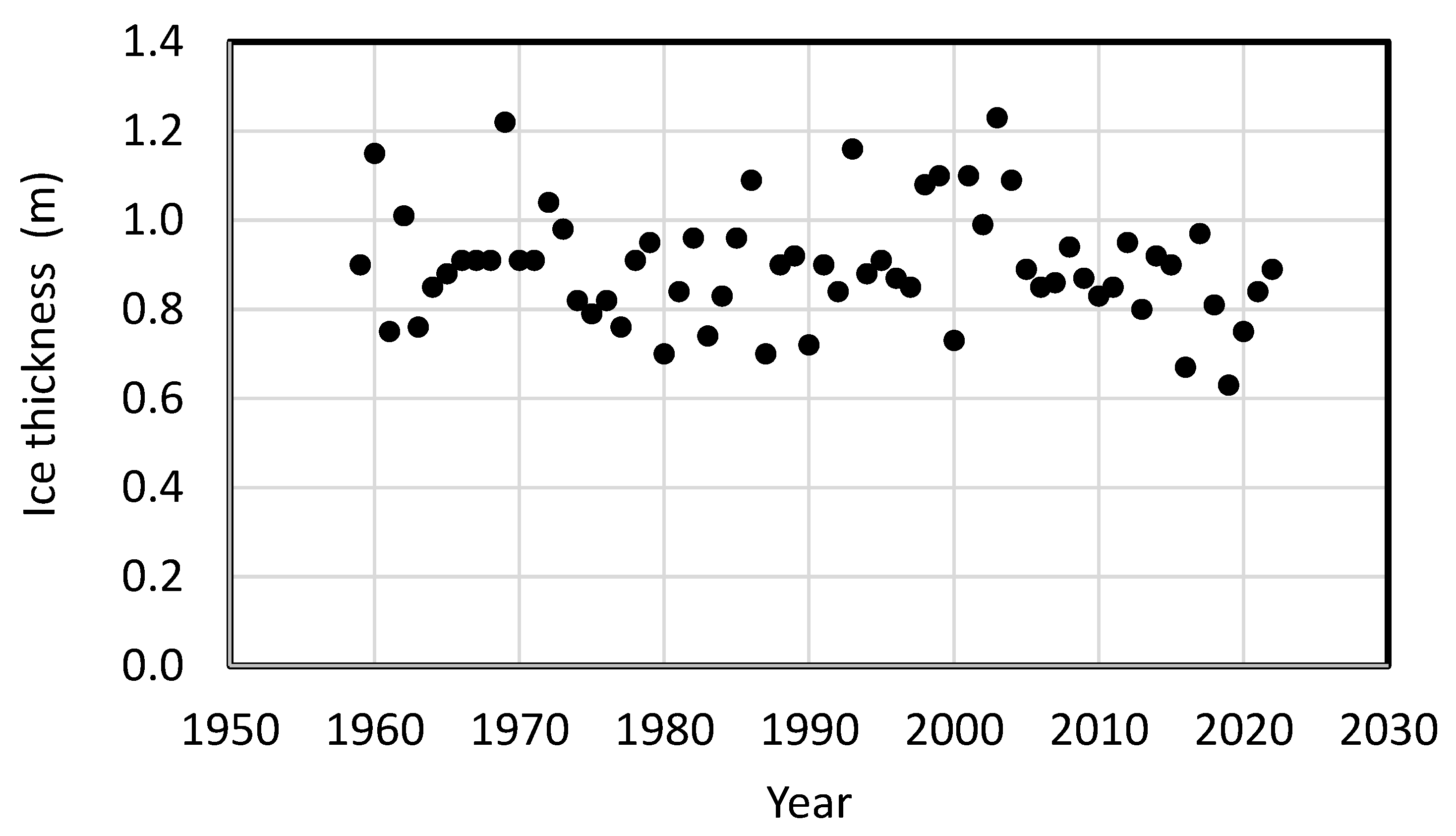
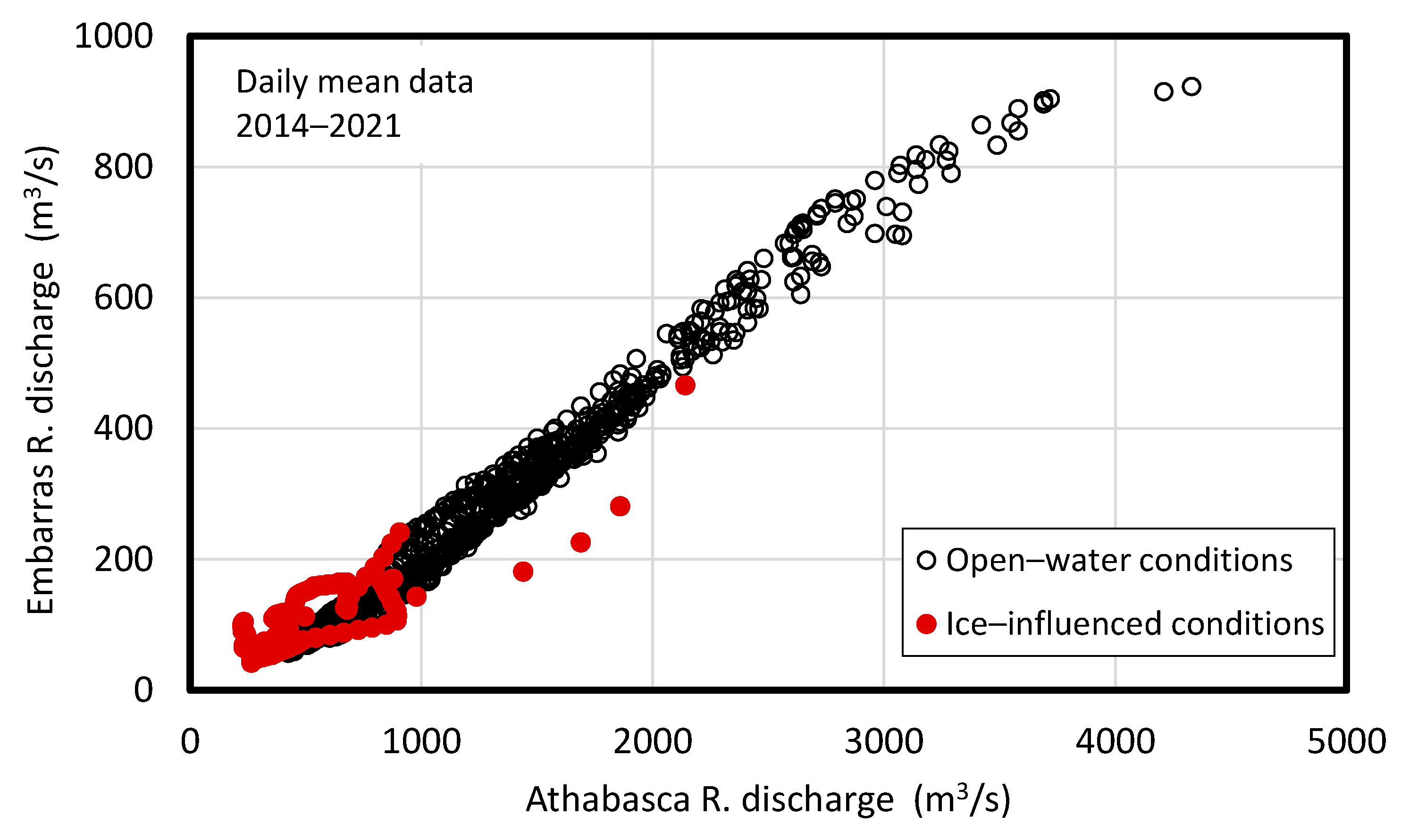

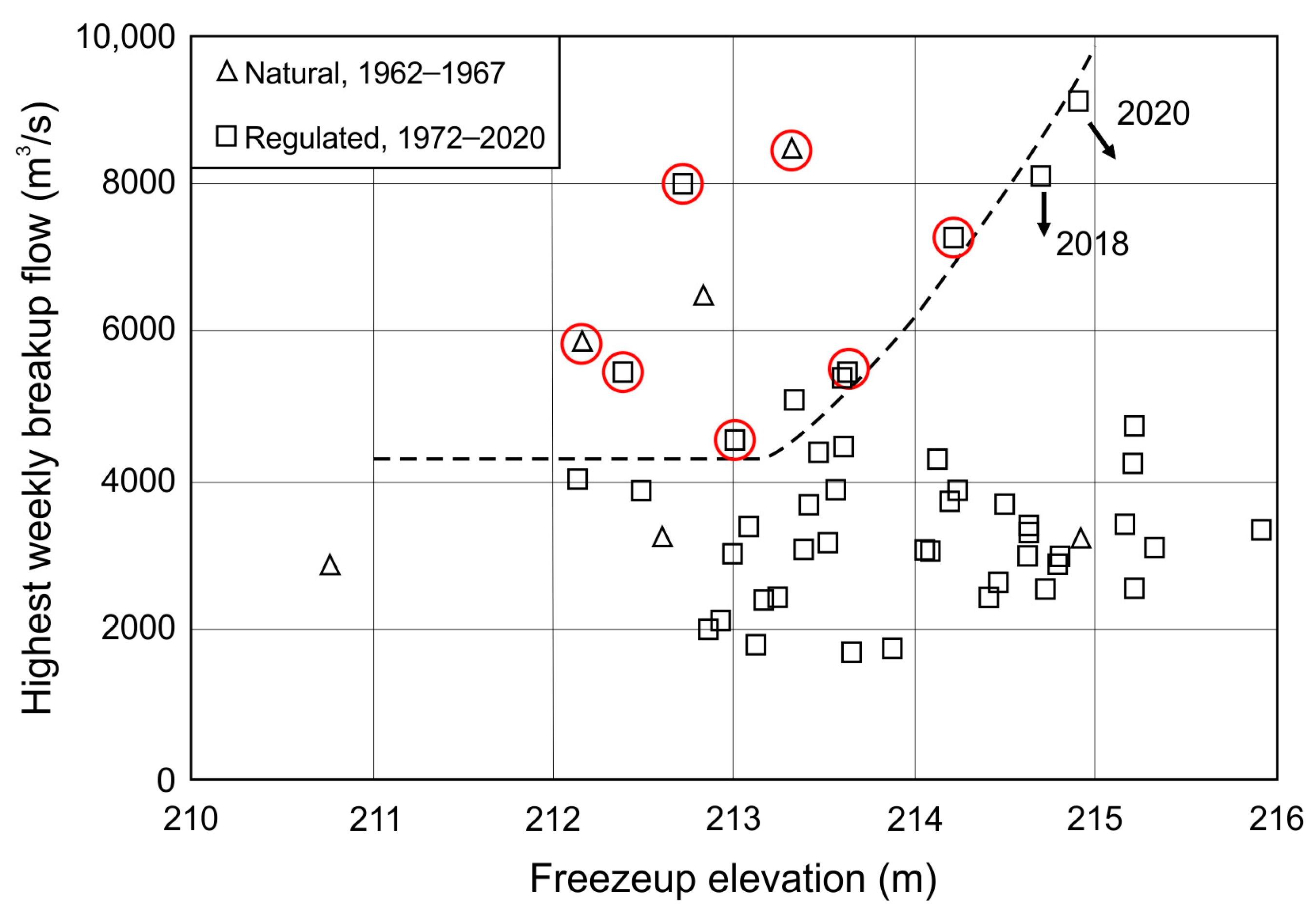
Disclaimer/Publisher’s Note: The statements, opinions and data contained in all publications are solely those of the individual author(s) and contributor(s) and not of MDPI and/or the editor(s). MDPI and/or the editor(s) disclaim responsibility for any injury to people or property resulting from any ideas, methods, instructions or products referred to in the content. |
© 2023 by The Crown. Licensee MDPI, Basel, Switzerland. This article is an open access article distributed under the terms and conditions of the Creative Commons Attribution (CC BY) license (https://creativecommons.org/licenses/by/4.0/).
Share and Cite
Beltaos, S. The Drying Peace–Athabasca Delta, Canada: Review and Synthesis of Cryo-Hydrologic Controls and Projections to Future Climatic Conditions. Sustainability 2023, 15, 2103. https://doi.org/10.3390/su15032103
Beltaos S. The Drying Peace–Athabasca Delta, Canada: Review and Synthesis of Cryo-Hydrologic Controls and Projections to Future Climatic Conditions. Sustainability. 2023; 15(3):2103. https://doi.org/10.3390/su15032103
Chicago/Turabian StyleBeltaos, Spyros. 2023. "The Drying Peace–Athabasca Delta, Canada: Review and Synthesis of Cryo-Hydrologic Controls and Projections to Future Climatic Conditions" Sustainability 15, no. 3: 2103. https://doi.org/10.3390/su15032103
APA StyleBeltaos, S. (2023). The Drying Peace–Athabasca Delta, Canada: Review and Synthesis of Cryo-Hydrologic Controls and Projections to Future Climatic Conditions. Sustainability, 15(3), 2103. https://doi.org/10.3390/su15032103







